#that type of animation is A LOT of work
Text
Look ive been seeing some hate on the new LMK s5 animation and i just wanna give my two cents on this matter.
Look... animation isn't easy... its a LOT of work. it takes a lot of time and patience. Just because the trailer doesn't look as epic as prev trailers/eps doesn't mean s5 automatically sucks.
don't be rude to any of the animators. pls remember that regardless of their amazing talent, they are still human.
and also... if you don't animate--wait forget about animation for now-- if you don't even draw, then you have NO right to judge these animators who put a lot of work into making s5.
it takes TIME and effort... its not easy.
im not sure if its just rumors or if LMK actually has switched animation studios but regardless... be glad that at least they aren't leaving LMK altogether. I know soo many shows where they just left the show at a certain season and left it at that-- with no proper ending.
but im soo grateful that LMK is still going on. and I'm grateful for that.
Quit being so rude about the animation. It may not be picture-perfect but you have no right to judge or be rude.
How would you feel if your work (which you spent a lot of time on) was condemned and ridiculed just because it wasn't as perfect as previous works? You wouldn't be smiling, that for sure.
So please stop all this preschool-behavior and be thankful that the show is still going on and isn't in the grave.
If you dont like the animation... keep it to yourself... there is no need to diss the show before you even see it. If you don't like the animation, fine.... don't watch the season then. its up to u
But please... if you have nothing nice to say, don't say it at all.
Thanks y'all. have a great day
https://kittenninja14.tumblr.com/post/731916269075480576/hey-yall-i-just-found-this-incredible-video-and
#stop being rude#animation takes A LOT of work#especially with how advanced and epic LMK is....#that type of animation is A LOT of work#so quit being rude#anywyas#time for real tags ig#lmk#lego monkie kid#lmk season 5#lego monkie kid season 5#KN14 rambles#talkingwithmoi#KittenNInja14
42 notes
·
View notes
Text
Was just thinking about the amount of animals Obi-Wan interacts with compared to literally everyone else and in the Clone Wars episode where Kamino gets attacked he literally gets saved twice by the same ray-like animal and just...
The growth from judging Qui-Gon for the 'pathetic lifeforms' he picks up to whatever he has going on during the Clone Wars era. He must have gotten that from Qui-Gon though, right?
And because it's my brain and it's rotting with all the star wars stuff I am consuming I was thinking of Obi-Wan saving all these creatures and the 212th having to deal with that. Surely they made one of the rooms pet proof in case one of them needs a new home. There also have to be clones who love that because of course Obi-Wan can't really take care of rescues on top of all his duties.
After the first few times this happens Cody learns to order animal food and other necessities. And if the Republic doesn't fulfill these requests or asks too many questions he'll just have to make sure to organize them on planet during the campaigns.
#maybe they even keep a tooka or two#for the morale#but seriously#i have been thinking about writing a soft crackfic about this#just the 212th travelling with a whole zoo#already made up my own clones and all#cody is very done but it makes his general happy so who is he to complain?#when the 501st learn about it they start bothering Rex about it#or they ask Anakin ans Ahsoka to do thr same type of Jedi magics#they want pets too can you blame them?#obi wan is pretty oblivious to all of this#he just wants to help!!#and the tenth tooka was looking just *so* sad what was he supposed to do? leave it all alone and sad and scared?#it's just chaos all around#but also so soft#clones don't get a lot of chances to pet any animals during their training and war doesn't really offer these opportunities either#so whenever other battalions work with the 212th and learn about their zoo they get excited#accidental therapy animals for the clones#and the jedi because what better way to find the energy to keep fighting and bonding with an innocent lifeform that gets affected by the war#adoptions go wild#the wolfpack asks Plo for wolves#Plo struggles to say no#star wars#tcw#obi wan kenobi#212th attack battalion#commander cody#accidental animal acquisition#I just remembered vaguely that in one of the Jedi Apprentice books Obi Wan has a bird on his shoulder??#maybe he didn't get this from Qui Gon after all though I'm sure Qui Gon encouraged and reinforced that behaviour
75 notes
·
View notes
Text
Okay so- who’s gonna tell him (PHIGHTING!)
i have a few more of these planned so keep a look out for them :3
(Okay slight edit as I forgot medkits crystals LOL)
#Honestly I kind of suck at animating but I mean for not touching FlipaClip in like. What? A year#I think this looks pretty okay!#I’m planning a phighting vine compilation soon maybe just maybe#It depends solely on how much time I have because I JUST got hired by a friend to do a bunch of comms for him#And I gotta get those done by summer LOL#So my posts may be Fortnite based for awhile once I start on them LMFAO#As of now though I’m just gonna work on my mermaid au and random doodles and stuff#So there should be a lot more of those types of posts soon!#art#phighting!#artists on tumblr#phighting fanart#digital art#phighting#roblox phighting#phighting roblox#phighting art#roblox#my art#fan art#artwork#illustration#fan animation#animation#digital animation#2d animation#animated#art meme#funny memes#meme
75 notes
·
View notes
Text
i've been rotating the "this doesn't make any sense!" response to boy and the heron in my head and i wonder how much of it comes down to like...the kind of audience that engages with ghibli movies vs the kind of audience that mostly only engages with weird art movies vs the kind of audience that only really engages with blockbusters and marvel movies, and the overlap of those groups in the theater.
because, like, the boy and the heron is far and away more straightforward, from a plot perspective, than a lot of other Weird Extremely Personal Art Movies i've seen and love, but it IS a Weird Extremely Personal Art Movie even so. usually the only people seeing Weird Extremely Personal Art Movies, especially in theaters, are people who like that and expect that and have seen those types of films before and are therefore capable of engaging with them even when things aren't as clear as they'd be in an average blockbuster flick. like, nobody who only cares about Cinema to the extent of marvel movies and MAYBE john wick is going to see beau is afraid, and if they did they wouldn't have the tools to engage with such a dream-logicy movie. it would just be a weird thing that doesnt make sense to them, at least until they worked their media engagement muscles with other weird films. there's a lot of self-selection to the kind of person who usually sees these kind of movies.
while boy and the heron is weirder and more complex than a lot of other ghibli movies, as far as weird art films go it is incredibly, INCREDIBLY straightfoward. every weird plot point is explained very clearly to the audience, very little is up for interpretation from a strictly "what was the plot" point of view. boy loses mother. father remarries and moves the family. boy struggles to contend with grief. boy is pulled into a magical world by an old man who wants to use him. time is weird and fucked up in the magical world, but the movie is going to go out of it's way to highlight who's who and make it clear how the time travel works and the characters' relations to one another. the boy refuses to take over the magical world because he wants to live in the real world with the real people he loves. boy leaves the magical world having learned an important lesson about moving on. but the boy and the heron trusts its audience, doesn't handhold, and expects the audience to engage seriously and with focus to its plot and characters and stories.
a lot of people never watch movies like that! a lot of people are used to uncomplicated superhero movies and romcoms and that's it. the difference is that those people were never going to see beau is afraid, so the discussion about that movie instead comes from people who have the tools to engage with it. but because of the aesthetic-ification of ghibli, a lot of people who don't Do art films but are really into the aesthetics of cute little guys and girls in pretty dresses went to this art film and were confused that it was weird and dream-like and dark and strange and requires more of its audience than just passively watching.
anyway there's nothing wrong with not having the muscles to engage with weird art films, though i do think everyone should challenge themselves with the kind of stuff they watch. there's nothing wrong with preferring simple straightforward uncomplicated plotlines. but it is really interesting seeing people talk about the movie like it's insanely weird and doesnt make any sense meanwhile me and the friends i've chatted with about who DO have experience with this kind of film all feel insane because the movie is SO clear and SO straightforward by the standards we're used to. its just a neat crossover re: the kinds of movie fans that exist
#rain speaking!#does this make sense#its like if this was a live action more or even an animated movie from another studio half this audience would never engage with it because#it is on its face a weird strange art movie about the director working thru smth#but ghibli is as much an Aesthetic (a highly simplified 'cozy' and uncomplicated aesthetic that has very little to do#with the kinds of films ghibli actually makes) as it is a studio so a lot of ppl whod otherwise never touch this type of work#are going to be in theaters for it#WHICH IS GOOD!! i hope watching it inspires those folks to engage w more weird shit#sorry for the beau is afraid comparison they rly have very little in common it was just the first thing that came to me#when i was thinking abt other weird highly personal art films made by directors who are clearly#expecting the audience to have a really solid base under them re: their ability to engage with complicated films#boy and the heron spoilers /
92 notes
·
View notes
Text
TFS TUESDAY! BUT ACTUALLY TUESDAY THIS TIME!


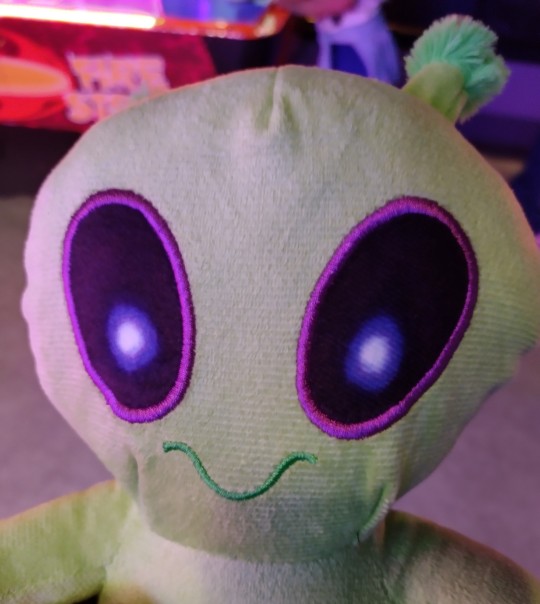
#last chapter was a lot#IN A GOOD WAY#a lot in a good way#it kills me how if they would just TALK TO EACH OTHER this whole thing could have been completely avoided#but thats not how people work. especially not kids and also toichiro is gonna do everything in his stupid power to keep them from being#friends again#i know im cutting it close its almost wednesday#BUT THE KEY WORD IS ALMOST#ITS NOT WEDNESDAY YET#where i am its not#SO CLOSE but not quite#fun fact that alien stuffed animal is something i won from a claw machine second try and when i got it i kid you not i fell to my knees#because i was so shocked#i shouldnt have touched the floor though it was probably gross#i just noticed tome's hair in that picture is longer on one side than the other and its going to bug me forever#typing all of this is keeping me from reading it so i'm going to shut up for a minute and get to the new chapter
52 notes
·
View notes
Note
You ever wish Sing had a bigger fandom? I sure do. Also what specifically do you like about the movies? Do they inspire you? Are they just fun to watch? I’m eager to hear!
Thanks for your thoughtful ask!✨
Yes, sometimes! If the fandom were bigger we’d get to see more beautiful artwork of our favourite characters. But because it’s small there are also advantages, such as we kind of all know each other! And there’s less drama which is nice. 🤡
Personally, I love the Sing movies because they have inspired me so much. As someone aspiring to work in a professional creative industry, I find it relatable to see how people overcome the struggles to getting a creative project done and to pursuing their dream when it feels like there are endless hurdles to jump. The Sing movies are fun to watch of course and the animation is absolutely beautiful, but I love that these are stories about what goes on in the lives of those working behind the scenes on a creative production! Sometimes, maybe most of the time, the stories being told behind a project are just as interesting if not more entertaining than the project itself! So that’s what I really love about these movies.
And Buster Moon has especially been a very inspiring character to me! (Could you tell he’s my favourite?! 🐨💞) He’s out living his dream, doing his best, even if it looks like failure to outsiders sometimes. He’s resilient and courageous about it, not letting others keep him down or take his joy in the theatre away. He doesn’t let fear stop him from doing what he loves. He’s passionate about his craft, he tries to maintain a positive spirit, and he’s such a hard worker. (Like in Matthew McConoughy’s book “Green Lights”, Buster sees a green light and he GOES for it!) And he inspires others to pursue their dreams. He’s not perfect but he’s got a good heart, and I love him 💖 He inspires me to have the courage to follow my dreams and do what I love, and to not wallow in depression over what I can’t control but to be positive and take action in what I can control. To be resilient and realistic about my art career, but to stay true to what I love and take joy in the process, even if things don’t work out the way I had hoped or if some don’t support me. Buster’s a fictional character but he represents the things I would like to be as an artist, so I’m drawn to him. 💖
Again, thanks for the thoughtful ask!✨ I’d be curious to see how the Sing movies have affected other fans’ lives too! If I ever have a chance to meet Garth Jennings I’d want to tell him about how these movies have had a positive impact on my life and art career☺️
(Here’s a little classic cartoon Buster and me: )

#sing movie#sing 2#buster moon#my art#ask#despite the fandom being small I think lots and lots of people love the Sing movies!#theatre kids artists creative types music lovers animation lovers we all love these movies#I want to work in animation#chasing that dream 🌴☀️
25 notes
·
View notes
Text
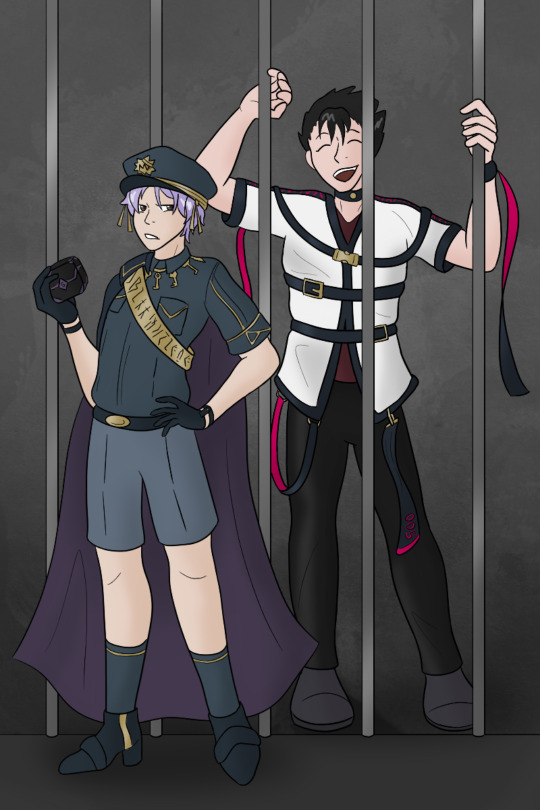
His ass is not going to be forgiven!!!
#ill tag this on my other blog#exhausted nonbinary warden my beloved...#shimazaki would make the worst prisoner ever#hed be the guiltiest bastard but also the fandom would thirst over him#i havent put my finger on his murder yet#theres a reason i havent made any milgram ocs -- im really bad with coming up with balanced crimes asdfsdf#i cant go with his typical terrorism or trying to beat up a literal child... but his personality isnt suited to anything indirect#all i know is his video would look just like the s2 opening >:3#very cool and colorful animation#spoons - vegetables - cacti type symbols#the dreamscape is very colorful but all his real memories are in complete darkness#a lot more sound effects than the current videos#that magenta is from his aura -- i think it works well for his color#im incredibly glad i havent seen any es x prisoner stuff but i can have a little warden x prisoner drama. as a treat >:3#ill have to find a fun cover song for each of them but yeah :D
25 notes
·
View notes
Text
Ahh, tv shows where I can't tell apart the male leads, my beloathed.
Seriously either we need to go back to lighting our sets more, or long hair on men needs to come back into vogue, because I can't keep living like this.
I can't keep taking two seconds to try to determine who is who every shot because I miss what's going on in the scene!
Controversial opinion, but you need to follow the silhouette rule in live-action projects too, at least in regard to characters in the same show or movie! If you absolutely *can't* hire actors with different heights, hair, or builds, you need to work something out with the costuming department to get a distinct shape!
#fan wank#ignore morg#It doesn't even necessarily have to be that long smh just pick a man to not have the sides short?#I mean I'd like it longer because it looks better imo but for functional reasons changing the shape of their head would work!!!#Also the better your lighting is the more effective smaller changes to hair or costumes (or the actors faces lol) are likely to be.#Sometimes it's not even a lighting issue that creates an issue with the costuming.#Like I respect the use of a color filter for setting mood but if you use one you NEED different silhouettes!#Like this one appears to have *tried* with the guy with the earring but it's not enough.#There are few enough of that kind of fun-spooky type of romp that I feel left out by not being able to watch Ghostbusters.#(not that OG ghostbusters doesn't have other annoying elements but this one actively interferes with comprehension for me)#It's really disappointing running into another one.#I guess I should be grateful I don't watch a lot of a certain kind of anime because a few studios have a very similar problem.#Though in that case they're more likely to use the hair to fix the comprehension-affecting part of the problem.#Yeah I'm not making a particular effort to *hide* what show I'm vagueing. Just like I'm not doing much to hide my disappointment.#god fuck these unnecessary accessibility issues in live action seriously it's so goddamn frustrating.
3 notes
·
View notes
Text

woag. golems
#sprites#modding#ironically. the base golem is my least favorite#the inferno golem i like the magma i did on it#but the ice and wood golems im very happy with#i didn't even know wood golems were a thing in BD and that's bc 'wood golem' is only an enemy in the BD2 demo#it's model is reused for a group of enemies in the full game and the specific texture is reused for 'woody' but#i saw there was a wood golem of any variety and was like 'oh that's sick what if i give each of the vanilla races their own type'#with wood for elves obviously. rock for humans. inferno for goblins. and ice for dwarves#at least ideally. for some reason animal entity tokens wont actually give dwarves the ice golem#every other race's animal token works great. just not dwarves#so ice golems are just a common domestic instead#close enough#the wood golems im trying to make an actually tough plant type enemy so elves have a lot of fire power in sieges#so far they're pretty tough! turns out making them made of A Lot of tissue layers makes them a lot more durable
11 notes
·
View notes
Text

woe characters inspired by some of my cats be upon ye. info on them in my tags lol
#dialtown oc#jack dlc#twerpys head is a sledgehammer bc the cat theyre based on was born in a wall lmao#he works at the petstore with outis bc i got said cat frm the local petstore#lilys head is a fluffy couch pillow thing and she works at an animal shelter bc thats where i got the cat shes based on#twerpy is genderfluid bc we make jokes that my cat twerpy is genderfluid a lot#also i feel like shed be aroace if she were a person. its just the vibes yk#lily isnt labeled as anything shes just vibin#the 2 are part of a big sorta found family type shit that consists of chars based on my other 3 cats i just didnt feel like drawin more rn#twerpy is really mean and stuck up but is secretly super sweet it just takes them a long time to warm up enough to someone n show it#shes also secretly incredible at like. comforting people and helping them out. but again only shows it for people hes warmed up enough to#lily is super confident and full of herself and spoiled. she thinks shes super fuckin smart but she is very much Not /lh#she loves attention though and gets her feelings hurt super easy#also shes Huge on physical affection. she loves giving people hugs and holding hands and shit#like. shell be like oh im so fuckin hot and cool literally no ones on my level and of ur like eh idk that fit isnt really that good on u#she will start Crying. and get mad that youre being mean to her for no reason while sobbing#and probably will hug onto you while doing it#twerpy also gives really good hugs but they Hate being touched. so if it willingly touches you then youre incredibly lucky special#also lily loves sitting in peoples laps#if youre friends with her she is far more likely to sit on your lap instead of any chair in the room nd thats just smth youll have 2 deal w#dlc wiki
22 notes
·
View notes
Note
hello there fellow gay ww1 enthusiast :D
*pointing dramatically through the crowd* ah hello!!!! there are others out there…. the few the proud….. through posting this stuff online i’ve met a handful of other gay ppl who are into this era but a majority have been what i have to assume are straight guys who really like war and guns and war movies with guns! so it is always nice to find community here and there :^)
#asks#spoopinatur4l#and also drawings of anime girls in the trenches#but who am i to judge#i was so caught up in my little circle of gay 1917 fans that i forgot the demographic for these sorts of things#there’s some stuff i don’t post on twit bc it’s very homosexual in nature and i don’t want to deal with ppl there#and also not on insta bc my entire family and a lot of my coworkers follow me there#tumblr is my last gay bastion#this is to say like 95% of the guys i’ve posted here are at least a little fruity#the homosexual implications of war and all that#ANYWAY thanks for the ask thank you gay ww1 enthusiasts i love you so dearly#i should also say that i rly appreciate ANYONE who looks at or likes my work i’m not trying to say that it’s a gay ppl only club#just that the shift in the type of ppl who looks at my work as it’s gotten more attention is a little novel to me#if u are someone who has enjoyed my work then i am kissing you directly on the mouth
41 notes
·
View notes
Text
On Jōnouchi's ADHD (1.39k words)
This headcanon is probably the longest on this blog; it's some compiled thoughts on how growing up with (undiagnosed) ADHD has affected Jōnouchi. It's halfway between headcanon and fanfiction piece, and was requested by @bloodyscott, whom I kept waiting for too long for a response. I apologise sincerely for the delay.
This headcanon begins below the cut, as it's obscenely long. You may find it more comfortable to read this from the blog page, or on Archive of Our Own (NOTE: tumblr is acting strange. To access the page, copy the link and manually remove the href.li portion and the second https), rather than on your dashboard/search, in terms of formatting and such.
From infancy, Jōnouchi wailed his way out of his crib, out of his room, out of his house—as a baby, he thrashed towards whatever freedom he could find. He loathed the four walls of the crib; he'd scarce room to move. A skin infection brought him, aged 4, to hospital, and the very sight of overrun grey plastic seats and skinny cubicles exhausted him more than his illness had ever threatened to.
In primary school, others’ desks would blend together in a whir. Here he was, stuck, dizzyingly sedentary—the longer he sat, the foggier the world seemed to grow. When he kicked and whined at other children throughout electric lunch breaks, and they shrank from his vitality, he learned to eat alone. As his peers trudged from class in packs, watching the pavement, he sat, sullen, as his father drove him home. Somehow, Katsuhiro had never trusted him not to lose himself in chasing his surrounds. The fabric of the car seat would bite into his shorts, and he’d squirm for the window, squealing towards the noise outside: Birds that cawed; scraps of paper that fluttered and choked on smog. That was a fragile era, when his mother still waited, with dry hands and chipped nails, at home. When his father already stank of beer, but still spoke loudly, deeply, boisterously. Again and again, Jōnouchi’s mother would sit her son down, and write his name, stroke by agonising stroke. She’d recite each mora in time with each character. Yet sound would cluster through his head, and his own name would dissolve amid his mother’s instructions, amid the blaze of sunlight trapped on the windowsill behind her. He would write, and the strokes would come out rushed, mis-ordered, lopsided.
Iro wa nioedo
chirinuru wo.
At 10, his father grew quiet, and his mother yet quieter. Silence took up like a plague in Jōnouchi’s head, and swarmed in shapeless formation throughout parched mathematics lessons. Times tables hurled themselves headlong into a skull full of fog, and burst on contact. Are you listening? a teacher asked. How could he listen with a head full of noise, of unspoken words billowing back and forth? He gripped his seat, and glared back. Why should I care, anyway?
When his mother left, his father stopped caring to chaperone him. It had taken Jōnouchi a decade to earn the right to shed his infancy. He resented that it had been this long, so tried to join the huddle of middle schoolers. He told odd stories, and took off, queasy, in front of them. They withdrew their smiles when he approached on the second day. He growled his plaint, and resentment drove him to take the opposite route. He explored back alleys, wallflower convenience stores and dilapidated cinemas; the faster he walked, the more clearly he could see each brick, and the brighter each fleck in the pavement glinted. At speed, he delayed the journey home, and set his eyes on a gorgeous early winter sunset. The colours bellowed, too bold for winter, ungainly and vain. They were glorious.
Jōnouchi came home late. His father glared; fog crashed back down on his shoulders.
Wa ga yo tare zo
tsune naran?
A week before she cleared out too few of Katsuhiro’s belongings and packed too few suitcases, Jōnouchi’s mother drove both children two miles to the optometrist. My son, she explained, reads slowly, yet resents reading; it seems he can’t see very well. My daughter’s sight seems clearer, yet she complains of pain. The optometrist forced Jōnouchi to read down a chart of letters; he fidgeted, and, consumed in memories of a lonely lunch break the day prior, passed with flying colours. When the optometrist flashed a light to photograph his eyes, whatever hideous miracle that was, Jōnouchi screamed.
Katsuya Jōnouchi, the optometrist surmised, had perfect acuity of sight. He sought attention, stimulation. Meanwhile, Shizuka Jōnouchi, who had sat entirely still throughout her examination, had more ragged, derelict peripheral vision than her family had anticipated. Untreated, both your children will get much worse.
And in the months after Shizuka Jōnouchi became Shizuka Kawai and Mrs. Jōnouchi became That Bitch Who Never Cared, Katsuya Jōnouchi became horribly aware of how little time he had to be lethargic. He had to survive this schism; yet as he was, he barely felt capable of thinking. He walked, fidgeted, paced to prove to himself that he was a moving, breathing organism. Yet his father’s frustration would brook no exuberance. Long before Katsuhiro fully committed to flinging glass and spurning his son’s misery, Jōnouchi began learning to move silently, slowly, around his father. He memorised which mats snapped and snagged, which bits of fabric hissed when stepped on. He noted which windows opened most quietly. And yet he never managed a perfect, quiet exit. He couldn’t help but be conspicuous; he could only hope to get out too quickly for his father to react. And, to lift the torpor that followed escape, he would run to school, and, after, run back. Never did the sun shine brighter than when he was moving.
Uwi no okuyama
kyou koete.
When he met Hirutani, did he become more violent? No; every punch he threw during his delinquency had waited, kinetic and desperate, for days, months, years. In classrooms, his sole responses to being ordered around had been sullen deference, with sullenness being his sole demonstration of rebellion. Now, threatened with the obsolescence of his ego, of his perceived freedom, he chained himself to violence, over and over. The first time he punched a man in the gut, he found himself shaking. And rather than sink into sallow, domestic remorse, he slathered himself in white rage. And he went back and he went back and he went back, helpless to his own instincts, trying to dredge the noise in his skull out through his fists. No matter how many punches he threw, and no matter how many he received, he could not stop his head from blazing anew the moment he walked away.
Did Duel Monsters afford him any peace? He would be no man’s losing dog; nor would he be confined to dull celebrity. To play as a strategist consigned him to sitting still, committing himself to gambits he could never entirely trust, to moves that demanded a clear head. To play too whimsically would doom him to inferiority. Thus, he gave half his heart to diligence, and half to sheer fortune. Nobody could idolise his kind of folly, nor devalue his kind of skill. This was Jōnouchi’s will—to eschew having to wait in the mire of expectation; to escape the fog of obligation to anyone’s morals but his own. Honour suited him, so long as it was on his meticulous terms. In games of Duel Monsters, he became a knight-errant of sorts: predictably unpredictable, unexpectedly canny, blindly faithful. With this relationship to his own fate laid out so, he could finally draw cards without fearing those next to come. And thus, hyperkinetic, he found a peace in the game. So he played and played until he forgot how long he’d been playing, and Duel Monsters became as second nature.
Asaki yume miji
ei mo suzu.
Two weeks before Jōnouchi’s graduation, Shizuka invited him to her place to dine. Their father was not to join them. Jōnouchi protested, and his desperation died in a pinprick throat. Wisteria spilled itself over the footpath. Each step threatened to plunge, vertiginous, to the ground.
When Jōnouchi saw his mother, his throat turned to sandpaper. She looked so old.
You cried so much as a baby, she told him. Kicked and screamed to see the world. You weren’t comfortable waiting in your crib—I’d end up coming to you at 4AM, walking you around the perimeter of the house till my heels burned. And you seemed so afraid of all the noises of the night—groaning engines, singing birds. Now, look at you—you’ve grown up so terribly fast.
Could he afford to tell her how even now, he bit down the urge to kick and scream, to launch himself, all fists and sparks, onto his tormentors? No; so, all night, he gripped his glass as tight as he could. The cold lingered and itched on his palms for days. Holding onto things, it seemed, was not so difficult as he’d once believed.
#couple of notes: i tried to write jōnouchi as also possibly having some form of conduct disorder that did not progress to aspd.#as i have neither conduct disorder nor aspd – i can't promise it's entirely accurate#and i apologise sincerely for any serious mistakes. i've tried to avoid stigma but i know i've a hell of a lot more learning to do#jōnouchi is meant to have combined-type adhd here. i have adhd but no diagnosed subtype#however i'd generally say i have an extremely different experience to jōnouchi here. (i'm either hyperactive or combined)#i've tried to stay away from stereotype while also focussing on how a young child might be both overtly and internally hyperactive#and how the display of symptoms might change with circumstance.#moreover; shizuka's eye condition in the anime is left vague and (probably unrealistically) curable#i went with some kind of glaucoma (probably open-angle but i really don't know enough to say).#she probably stopped losing vision after surgery but i doubt she actually got her peripheral vision back#the japanese poem interspersed throughout is the iroha. it was more significant to early drafts and i'm too sentimental to take it out.#i named jōnouchi's father katsuhiro (克弘) because calling him 'jōnouchi's father' got too cumbersome#i didn't really show jonouchi hyperfocussing much or write about his experience of time.#but since he's an esfp i probably need more time to work out how Se dominance could interact with time blindness#anyway. i'll shut up now.#yugioh#yu-gi-oh!#YGO#Yu-Gi-Oh#yu gi oh#katsuya jonouchi#katsuya jounouchi#jounouchi katsuya#jonouchi katsuya#shizuka jonouchi#shizuka jounouchi#jonouchi#城之内克也#tw domestic violence#cw domestic violence
11 notes
·
View notes
Text
Jujutsu Kaisen Hanakotoba Analysis

⋘ ──── ∗ ⋅◈⋅ ∗ ──── ⋙
-> Black Lily
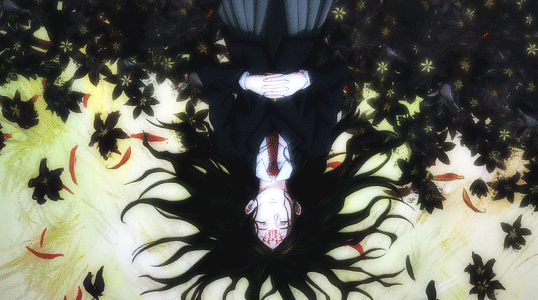

The flowers pictured in this scene are black lilies (Lilium) which are known as kuro yuri (黒百合) in Japanese. Its hanakotoba meanings are “love” and “curse”. In Western floriography, they symbolise rebirth, transformation and the appeal of the unknown. In the scene pictured above Tsumiki Fushiguro is seen surrounded by myriads of black lilies which is fitting considering she was cursed and fell into a coma. Cursed love is a significant theme in Jujutsu Kaisen, particularly in the prequel film Jujutsu Kaisen: 0. In the film, Gojo says, "Love is the most twisted curse of all." This perfectly encapsulates the symbolic meaning of the black lily.
-> Black Petunia
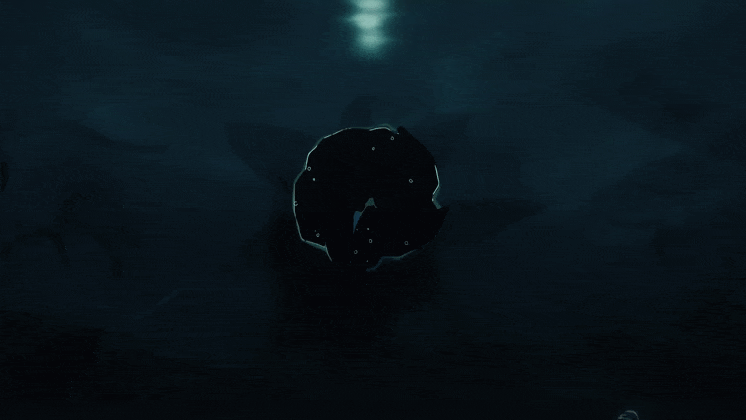

“Made my decision,
I won't go back anymore, and I won't regret it.
Watch as I change reality.
Even if the truth is cruel...
Catastrophe will be overwhelmed..."
(Vivid Vice, Who-ya Extended)
While the flower pictured in Jujutsu Kaisen’s second opening, Vivid Vice, is often thought to be a black lily; it more closely resembles a black petunia. Petunias are known as pechunia (ペチュニア) in Japanese and hold the hanakotoba meanings of “peace of the heart” and “with you, the heart will be soft”. In Western floriography, petunias mean “your presence soothes me”. Darkness, mourning, and resentment are associated with black petunias. However, black petunias also have the enigmatic connotations of strength, mystery, and uniqueness.
In the opening, a black flower, presumably a petunia opens up while a juvenile Emperor Angelfish (Pomacanthus imperator) swims around it. This fish is thought to represent Junpei Yoshino while the flower is thought to represent Yuji Itadori. Additionally, throughout this Jujutsu Kaisen’s opening sequences water has been shown to represent danger and destruction. Thereby making this scene a depiction of how Yuji’s strength has blossomed because of having undergone serious loss and being nurtured by danger and destruction. Both Yuji’s background as well as the origin and full extent of his unique abilities remain shrouded in mystery. This ties in with black petunias symbolizing strength, mystery and uniqueness. In addition to this Yuji’s kindness, upbeat and easy-going personality bring a sense of reassurance to those that know him well. The other connotations of the petunia, which include "your presence soothes me," "the heart will be soft with you," and "the peace of the heart," are all related to these attributes.
-> Red Spider Lily
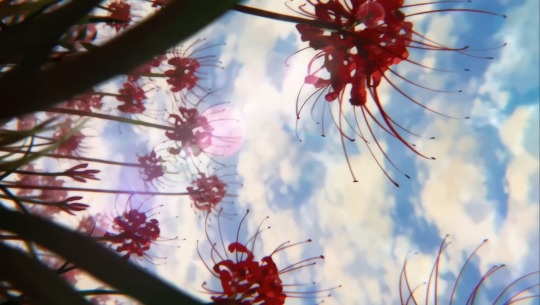
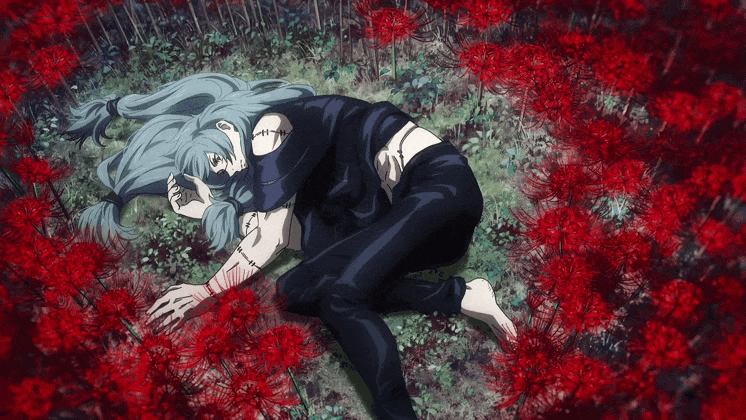

“Memories are fragile
I have no use for yesterday
So the moon is dark, twisting light
Where shall I go tomorrow” (Akari, Soushi Sakiyama)
“Indomitable spirit and immeasurably bottomless love and hate
The everlasting half-melted life bound to the fallen” (Avant, Eve)
In Japan, red spider lilies (Lycoris radiata) are known as higanbana (彼岸花) which means autumn equinox flower. They represent sad memories, resignation, independence, lost memory, abandonment, passion and those who are never to meet again in Japanese hanakotoba. The red spider lily is also associated with death, goodbyes, rebirth and the far shore (land of the dead). The red spider lily's symbolic meaning of farewells and rebirth is embodied in classic Japanese artworks depicting mythological situations, where they are referred to as the "flowers of heaven.“ In Japan, there is a strong correlation between the Buddhist and Shinto religions and red spider lilies. These striking flowers are thought to represent rebirth and the transience of life.
They are also believed to guide the deceased's spirits transition to the afterlife. They are frequently observed blossoming next to cemeteries or other holy locations. They are also thought to have protective properties that shield against negative energy and evil spirits. Red spider lilies are also thought to symbolise the boundary between life and death in Japanese culture. This is because its flowers bloom during autumnal equinox when Japanese Buddhists believe that deceased people's spirits return to the near shore (the world of the living).
Some legends claim that when an individual crosses paths with someone they will never see again, red spider lilies blossom alongside their path. These legends are partly responsible for the flower's affinity with final goodbyes, in addition to its association with death and the hereafter. This flower is also regarded as a symbol of both death and rebirth and are described as the flowers that grow in hell in the Lotus Sutra. As a result of this, certain Buddhist traditions in China and Japan believe that these flowers aid spirits in crossing from the afterlife into reincarnation.
The flower's sad symbolism for loss and parting is based on an ancient Chinese legend about two elves, Saka and Manju, who were the guardians of leaves and flowers, respectively. They could never meet, however, because the red spider lily never sprouts flowers and leaves at the same time. They both yearned to meet one another, and they violated the gods in order to do so. The gods punished them harshly for this and separated them for eternity. The flower is still associated with loss, both of loved ones and of memories.
Despite their frequent association with death and parting, red spider lilies are also admired for their beauty and resilience. They can survive in a range of challenging environments, including rocky and riverside locations, and their vivid red hue helps them stand out against the surrounding scenery. As a result of this, these flowers can also be seen as a symbol of strength and perseverance in the face of adversity. The red spider lily also represents beauty because of its vivid, vibrant red blossoms, which give a sense of elegance.
Red spider lilies are pictured in Jujutsu Kaisen’s 3rd ending theme as well as the opening credits for its mobile game, Phantom Parade.
In ED3, the flowers could be a harbinger of how various characters in this arc will meet their impending deaths, separating them from everyone else. The final panel of this ending depicts Gojo and Geto walking beneath a bridge. The underbridge in the real-life location on which this scene was based is only a single-path bridge, however here the bridge splits into two opposite directions. This is similar to legends that state that when a person meets paths with someone they will never see again, crimson spider lilies bloom across their path. This alludes to how Gojo and Geto will part ways at the end of the Hidden Inventory Arc and will never walk alongside each other again.
In the Phantom Parade OP, myriads of spider lilies are pictured under an ominous sky surrounding Mahito and Pseudo-Geto. The use of these flowers here foreshadows their connection with the far shore, their association with human souls and bodies, and their nefarious schemes involving carnage and death.
-> Cherry Blossom

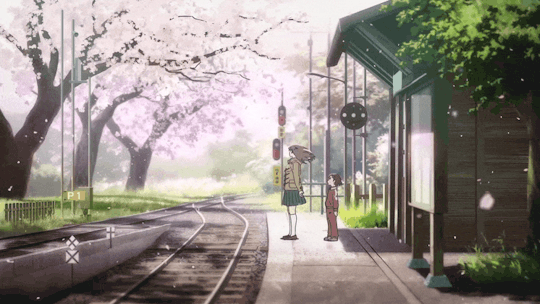
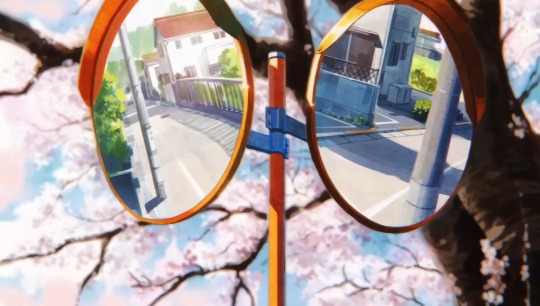

“And now, I can only imagine my future taken away by a curse.
Running and falling,
embracing these wounds that won't disappear...
The world awaits for this moment.”
(Kaikai Kitan, Eve)
The cherry blossom (Prunus) is known as the Japanese cherry and is the unofficial national flower of Japan. Its Japanese name Sakura (桜) has been derived from the word “saku” which means “to bloom”. Its hanakotoba meanings are “beauty of spirit”, grace, chastity, excellent beauty, gentleness, good education and the “transience of life”. In Japan, cherry blossoms are also a symbol of the “beauty of impermanence”—a Shinto concept better known as “mono no aware” (物の哀れ) as their falling petals are a reminder that although life is short, it is beautiful and should be savoured.
The Japanese concept of “natsukashii” (懐かしい) likewise emphasizes the fleeting nature of cherry blossoms. This concept refers to the happy-yet-wistful nostalgia for times and things that we will never be able to go back to. We will never get to experience those moments again, just like the ephemeral cherry blossoms, which makes them even more significant.
Cherry blossoms bloom from March to April which is the start of the new fiscal year in Japan. As a result of this cherry blossoms have also come to symbolise new beginnings and springtime. Given that feudal Japanese soldiers associated cherry blossoms with honour, discipline, and dignity—falling flowers were thought to be symbolic of a Samurai's death. In Western floriography, cherry blossoms herald the changing of the seasons and symbolise renewal and rebirth. They also symbolise the fleeting nature of life, tenderness, forgiveness, strength, beauty, love, confidence, peace, friendship and gratitude.
The Cherry Blossom's association with "happy-yet-wistful nostalgia for times and things that we will never be able to go back to" is reminiscent of both Gojo's and Yuji's carefree high school days before the Hidden Inventory Arc and Shibuya Incident respectively. The transiency of life is a central motif in Jujutsu Kaisen, as being a Jujutsu sorcerer means facing the threat of death around every turn. "No matter how many allies you have around you; when you die, you'll be alone". This line said by Gojo reinforces that one's time in life is finite and that nothing can stop death. Even if you have your loved ones with you at the time of death, they will not accompany you on your journey to the hereafter.
-> Ginkgo

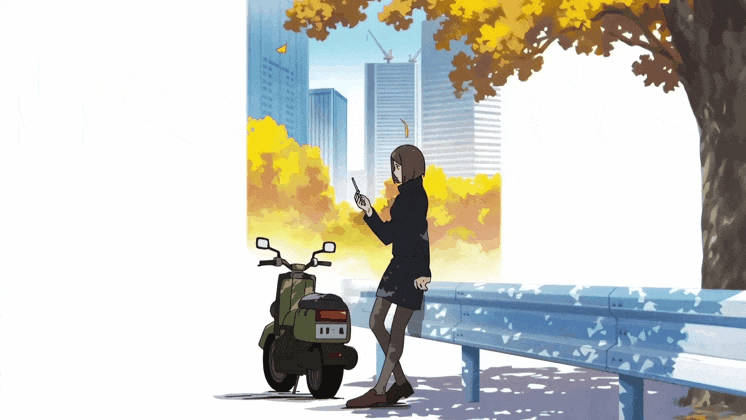


In Japan, ginkgo trees (Ginkgo biloba) are called ginkyo (銀杏) and symbolise magnificence, longevity, requiem, strength, hope and peace in hanakotoba. In Western floriography, ginkgo trees symbolise solemnity, longevity and requiem. The beauty and symbolism of the ginkgo tree are valued by many European cultures, who associate it with power, resilience, human progress, enlightenment, and memory enhancement. The ginkgo tree also represents renewal as shows off a magnificent colour display each autumn as it sheds its leaves to sprout new ones. In other Asian cultures, ginkgo trees are highly symbolic of longevity, endurance, resiliency, and hope. The ginkgo's symbolic meaning is said to be derived from the tree’s ability to survive under the harshest conditions as well as its long lifespan. When displayed as a single tree, it stands for strength and solitude.
Many of Jujutsu Kaisen's characters embody the Ginkgo's symbolic qualities of strength, power, resilience, renewal, and solemnity. Meanwhile, the tree's symbolic meanings of hope and longevity are contradicted by its brutal motifs and numerous tragic deaths.
-> Hydrangea


“Before my goodwill breaks down,
I should have told you everything.
In a life where night descends and dissolves,
The murky feelings flicker in the dim light.”
(Akari, Soushi Sakiyama)
Hydrangeas (Hydrangea macrophylla) are known as Ajisai (紫陽花) in Japan. Its meanings in traditional hanakotoba are pride, patience, coldness, heartlessness and temperament. Conversely, the flower is also connected with empathy and apology. In Japanese culture, the blossom has both positive and negative connotations, representing both deep or heartfelt emotion in addition to a fickle or changeable heart. In Western floriography, hydrangeas have both negative meanings—such as heartlessness, boastfulness, and coldness—as well as positive meanings—such as sincerity, honesty, gratitude, heartfelt emotions and deep understanding.
The hydrangea's symbolic meanings of pride, patience, coldness, heartlessness, temperament, and a fickle or changeable heart correspond to Gojo's character during the Hidden Inventory Arc and Geto's character post-Hidden Inventory Arc. The flower's connotation of deep or heartfelt compassion and empathy corresponds to Geto's character during the Hidden Inventory Arc and Gojo's character after the Hidden Inventory Arc. Hydrangeas are also associated with gratitude, sincere emotions and deep understanding, all of which characterise Gojo and Geto's friendship.
-> Osmanthus
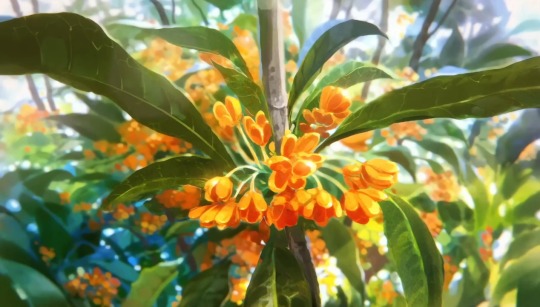

Sweet osmanthus (Osmanthus fragrans ) is also known as orange osmanthus, sweet olive, tea olive and fragrant olive. It is known as Kinmokusei (金木犀) in Japan and symbolizes a “humble and noble person” as well as “first love” in hanakotoba. Contrary to its sweet and wonderful fragrance, this plant only produces small, modest flowers, from which it is supposed to draw its symbolism of humility. The reason osmanthus symbolises nobility is supposed to have originated from the way that rain gracefully scatters the flowers without diminishing their fragrance. Osmanthus also symbolizes love, passion and sensuality in Japanese culture. In Western floriography, osmanthus flowers symbolize love, faithfulness, prosperity, happiness, fortune and protection. Orange osmanthus flowers in particular symbolize joy, optimism and serenity. Osmanthus flowers also symbolize honesty, spiritual enlightenment, elegance and beauty.
The Osmanthus flower’s meanings of joy, serenity, optimism, happiness, faithfulness and good fortune encapsulate the carefreeness of Gojo and Riko’s school days before the Hidden Inventory Arc. Its symbolic meanings of faithfulness, happiness, purity, beauty and optimism resonate with Riko’s character. While its symbolic meanings of spiritual enlightenment, honesty, elegance, protection, nobility and good fortune resonate with Gojo’s character.
⋘ ──── ∗ ⋅◈⋅ ∗ ──── ⋙
╰┈➤ Anime Hanakotoba Posts Directory
╰┈➤ JJK OP4 Traditional Symbolism
[I didn't go into much depth here since I wanted to keep things brief—because I know my other posts have been somewhat wordy lately... Please feel free to leave your thoughts and suggestions in the comments section. Also, I added new information that I missed to my "JJK OP4 Traditional Symbolism" post, so check that out if interested.]
If you liked this post, you should check out my other hanakotoba posts… I've created a convenient directory so you can locate them all without having to browse through my entire blog.]
#And yes I copied some of the flower descriptions verbatim from my tgcf post...#but it's a lot of unnecessary work to type out the same information twice just to word it differently...#you can't plagiarise yourself right... right?#jujutsu kaisen#jjk#jjk 0#jjk season 2#jjk season 1#jjk s2#jjk s1#jjk anime#jjk analysis#jjk hanakotoba#jujutsu kaisen hanakotoba#anime hanakotoba#hanakotoba analysis#hanakotoba#floriography#anime analysis#anime openings#anime endings#anime
16 notes
·
View notes
Text
going through it lately. and by it? i mean absolutely nothing actually.
#guys i need therapy#not that itll work#it wont#the last one didnt#and the ones before didnt but my mom only let me do one or two session each for those so i dont fault them#its been years tho so maybe?#idfk#i dont really care#i do#i probably do im just tired#yall know what type of tired#ugh i should really keep my vent posts to my vent blog so people dont have to see them#<- has made many vent posts here and actually not used the vent blog in months#my foot just fell asleep#yall lukcy i dont have a gun#i lied about quiting my job btw#something came up and it got complicated#it might turn out good tho#probably not#but if it does i might be able to move out and room with my oldest friend#oldest as in time known#not age (im older by like four months hehe(and like a head shorter but we dont talk about that shh))#but that would also mean rent which means philly will take a lot longer#and also ill have to look for shops in a whole other city so im putting off quiting for another month or two or three maybe#i dont like change. i dont like genuinely regularly thinking 'id rather die' to things that i really do want#tw vent#thats probably important#i dont like decisions#did you guys know Animal Jam got shut down?#i miss my necklace. everything else seems so- not barbaric but maybe unclean. which i guess is appropriate
3 notes
·
View notes
Text
I understand defensively, like personal protection dogs and such but I do think that breeding a dog to be human aggressive is a very very bad idea
#a lot of dogs are aggressive toward people they dont know going on their territory and thats fine!#bit selectively breeding for animals to be aggressive toward people offensively. that does not sit well with me#im also mostly talking about police and military work. i do not think that using dogs as offensive weapons is ethical#esp bc a lot of the breeds commonly used are herding breeds turned weapon#(a different type of herding than we're used to in the US but still)#which. i understand that there might not be a difference between offensive and defensive reactions in breeding#in which care i will sit back and resign my statement but this does sit wrong with me#(like. the biggest part of this is that i dont think its ethical to sick dogs on people. guard dogs are different)#(but i also think attack dogs are bad)#*not sit right with me
10 notes
·
View notes
Text
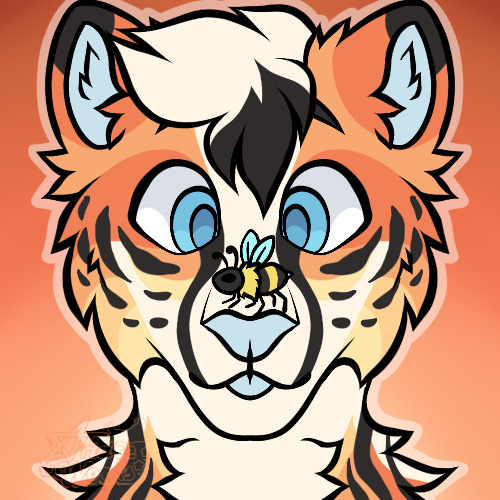

[OCs: Honey, Doctor Ell] These really make for great warm ups and in-between things!! So relaxing to do
#i swear I’ll post other types of art soon#I’ve been working on a very detailed animated icon#and it’s taken a lot of my drawing time#but it’s gonna be worth it#you’ll see :)#furry#furry art#sfw furry#furry fandom#furry commissions#art#furrydrawing#digital art#furry anthro#zomart#chibi#chibi furry#personal art
35 notes
·
View notes